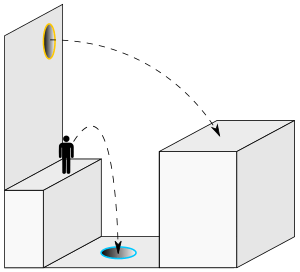Warp (video games)
A warp, also known as a portal or teleporter, is an element in video game design that allows a player character instant travel between two locations or levels. Specific areas that allow such travel are referred to as warp zones. A warp zone might be a secret passage, accessible only to players capable of finding it, but they are also commonly used as a primary mean of travel in certain games.[1][2] Warps might be deliberately installed within puzzles, be used to avoid danger in sections of a game that have been previously accomplished, be something a player can abuse for cheating or be used as a punishment to a player straying from the "correct" path.[3]
In some games, a player can only use warps to travel to locations they have visited before. Because of this, a player has to make the journey by normal route at least once, but are not required to travel the same paths again if they need to revisit earlier areas in the game. Finding warp zones might become a natural goal of a gaming session, being used as a checkpoint.[1][4][5]
Though it is unclear which video game first made use of teleportation areas or devices, the element has been traced back to MUDs, where it allowed connected rooms to not be "topologically correct" if necessary.[6] The element was later popularized by Super Mario Bros., in which secret areas referred to within the game as warp zones allowed players to skip forward through the game.[7]
Criticism

Author Luke Cuddy states that warps are used to keep the players entertained by "allowing them to jump to the next gameplay goal, straight into the action." However, he has also criticized them for robbing the player of the sensation of "being in" a virtual world, stating that "[b]y emphasizing destination over the places in between, warping encourages a 'quick visit, move-on-to-the-next-place' mentality that frames space as disposable."[7] Warps discourage exploration and may weaken the player's knowledge of spatial relationships.[8]
Ernest Adams critiques possible unexpected behavior by warp zones: "Teleporters can further complicate matters by not always working the same way, teleporting the player to one place the first time they are used, but to somewhere else the second time, and so on. They can also be one-way or two-way, teleporting players somewhere with no way to get back, or allowing them to teleport again."[9]
Despite the linear simplicity of Super Mario Bros., the game has been described as having a "surprising amount of depth and spatial complexity" in part due to secret warp zones found through the game.[7][10][11][12] Portal is a critically acclaimed game that uses warps as its core gameplay mechanic.[13][14]
References
- Gazzard, Alison (2013). Mazes in Videogames: Meaning, Metaphor and Design. McFarland. pp. 129, 142. ISBN 0786467940. Retrieved 2014-11-16.
- Fuller, M. and H. Jenkins (1995). "Nintendo and New World Travel Writing: A Dialogue". Sage Publications: Thousand Oaks. Retrieved 2014-11-17.
- Gazzard, Alison. Teleporters, Tunnels & Time: Understanding Warp Devices In Videogames (PDF). University of Hertfordshire. Retrieved 2014-11-16.
- Elias, George Skaff; Garfield, Richard; Gutschera, K. Robert (2012-08-24). Characteristics of Games. MIT Press. p. 16. ISBN 026201713X. Retrieved 2014-11-17.
- Grossman, Austin (2013-04-02). Postmortems from Game Developer: Insights from the Developers of Unreal Tournament, Black & White, Age of Empire, and Other Top-Selling Games. CRC Press. p. 89. ISBN 1136064621. Retrieved 2014-11-17.
- Aarseth, Espen (2006). Allegories of Space: The Question of Spatiality in Computer Games (PDF). MIT Press: Massachusetts. pp. 163–164. Retrieved 2014-11-17.
- Cuddy, Luke (August 2013). "Look Before You Warp". The Legend of Zelda and Philosophy: I Link Therefore I Am. Open Court. ISBN 0812696913. Retrieved 2014-11-16.
- Newman, James (2013). Videogames. Routledge. p. 118. ISBN 0415669162. Retrieved 2014-11-17.
- Adams, Ernest (2013-12-19). Fundamentals of Game Design. New Riders. pp. 332, 404. ISBN 0133435717. Retrieved 2014-11-20.
- Borries, Friedrich von; Walz, Steffen P.; Bottger, Matthias; Davidson, Drew; Kelley, Heather; Kücklich, Julian (2007). Space Time Play: Synergies Between Computer Games, Architecture and Urbanism: the Next Level. Springer Science & Business Media. p. 51. ISBN 376438414X. Retrieved 2014-11-17.
At first glance, the levels seem simple, but thanks in great part to the shortcuts, secret areas and Warp Zones scattered throughout the worlds, the game has a surprising amount of depth and spatial complexity.
- Oosterhuis, Kas; Feireiss, Lukas (2006-01-01). The Architecture Co-laboratory: GameSetandMatch II : on Computer Games, Advanced Geometries, and Digital Technologies. episode publishers. p. 103. ISBN 9059730364. Retrieved 2014-11-17.
- Davidson, Drew (2009-01-01). Well Played 1.0: Video Games, Value and Meaning. Lulu.com. pp. 30, 33. ISBN 0557069750. Retrieved 2014-12-18.
Ducking down a into a pipe can advance a player past a large portion of a level, but this also means skipping several rewards. Finding one of the game's 'Warp Zone' rooms lets the player skip past entire levels and worlds, but that forfeits any points that could be collected by completing those levels. ... Super Mario Bros. is so full of pleasant surprises that there are practically too many to count.
- Dan Adams (2007-10-09). "Portal Review". IGN. Retrieved 2014-11-17.
- Chris Watters (2008-04-29). "Portal Review: With delightfully unique gameplay and fantastically witty writing, Portal is a huge success". GameSpot. Retrieved 2014-11-17.